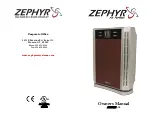
17
Brazing Refrigerant Lines
Refrigerant lines must be connected by a qualified
technician in accordance with established procedures.
1. Place a wet rag against piping plate and around the
line connections. Avoid overheating the control kit
cabinet, EXV and other internal components
Take
care to protect the Control Box cabinet, EXV or
other internal components.
WARNING
Danger of fire. Bleeding the refrigerant
charge from only the high side may result
in pressurization of the low side shell and
suction tubing. Application of a brazing torch
to a pressurized system may result in ignition
of the refrigerant and oil mixture. Check the
high and low pressures before applying heat.
CAUTION
Brazing alloys and flux contain materials which are
hazardous to your health.
Avoid breathing vapors or fumes from brazing operations.
Perform operations only in well-ventilated areas.
Wear gloves and protective goggles or face shield to
protect against burns.
Wash hands with soap and water after handling brazing
alloys and flux.
IMPORTANT
Refrigerant lines must be clean, dry, refrigerant-grade
copper lines. Air handler coils should be installed
only with specified line sizes for approved system
combinations.
Handle refrigerant lines gently during the installation
process. Sharp bends or kinks in teh lines will cause
restrictions.
IMPORTANT
Only use brazing rods/sticks which are suitable/
recommended for air conditioning pipework installations
- Do Not Use Soft Solder.
CAUTION
Purge low pressure nitrogen [1 to 2 psig (6.0 to 12.8
kPA)] through the refrigerant piping during brazing. This
will help to prevent oxidation and the introduction of
moisture into a system.
To prevent the build-up of high levels of nitrogen when
purging be sure it is done in a well ventilated area.
2.
Ensure nitrogen is flowing at all times during the
brazing process.
3. Braze connections. Allow pipe to cool before removing
wet rag.
4. Insulate both pipes individually.
Содержание VPB036H4M
Страница 43: ...43 ...
















































